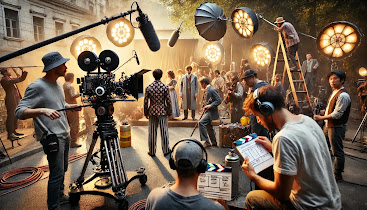Every film has key considerations before it is taken for an adaptation. Making literature-to-film adaptations is a complicated process that involves various stages, key considerations, and collaboration between various creative professionals. Here are the elaborated key aspects and elements of how early adaptations are typically made:
Rights Acquisition
- Securing Rights: Producers or studios need to acquire the legal rights to adapt a book for film. The stage often involves discussion and negotiation with the author and publisher to obtain licensing agreements.
- Consideration of Genre and Audience: Producers or studios look for stories which have a wide appeal or that fit within a popular genre to increase the chance of box office success.
Script Development
- Scriptwriting: A screenplay created once the rights are acquired. This might be done in various types such as in-house or by hiring a screenwriter.
- Adapting Narrative Structure: Screenwriters will condense, change or entirely reimagine the work of art's narrative to fit the format of film, which typically lasts between 90 and 180 minutes. Key features such as pacing, development of the character and dialogue are heavily considered.
- Collaborative Input: Stakeholders, including producers, directors and the original author, provide various feedback during the scriptwriting process.
Pre-Production
- Casting: Depends on the vision for the film, casting directors conduct auditions to select actors who fit for the characters inspired by the book.
- Budgeting and Funding: Producers fix a budget and secure financing, which might involve studio funds, investors, or crowd-funding.
- Creative Team Assembly: Essential crew members are hired, including the director, cinematographer, music director, setting designer, costume designer, and more.
Storyboarding and Planning
Visual Planning: Storyboards are created to visualize key scenes, determining how they will be shot.
Location Scouting: Producers and directors explore suitable filming locations that reflect the book’s setting, whether it's a real environment or constructed sets.
Production
Filming: The actual production of the film takes place over several weeks or months, depending on the complexity of the shoot. During this stage, the adaptation may continue to evolve, with changes made based on logistical challenges or actor performances.
Directorial Interpretation: Directors often bring their vision to the adaptation, which can influence how characters and scenes are portrayed compared to the source material.
Post-Production
- Editing: Once the editing process of filming and footage editing is done, crafting a coherent narrative, integrating audio effects and it's design, music, and visual effects are needed.
- Test Screenings: scarcely, films are screened to test the responses of the audiences. The reactions of the audience might lead to further transitions in the output of the film.
Marketing and Distribution
- Promotional strategies: After the film is ready for the release, marketing campaigns are launched, often involving trailers, posters, motion pictures, teaser, and interviews with cast and crew.
- Release platform selection: Decisions are made regarding whether to release the film theatrically, via streaming platforms, directly on digital formats, or something else.
Reception and Feedback
- Critical and Audience Responses: once the film is released, reviews and audience feedback are analyzed. Criticism may occur in between to the film by comparing the film to the book, impacting future adaptations and the legacy of the original source.
Additional Considerations
- Balancing Fidelity and Creativity: Frequently, Filmmakers face the challenge of balancing fidelity to the source material with creative freedom. Changes that enhance the narrative or fit the cinematic medium might be necessary.
- Cultural Sensitivity: Attention to cultural and contextual elements of the source material is difficult and crucial, especially when dealing with adaptations from diverse backgrounds or historical contexts.
.jpg)













Interesting!
ReplyDeleteThank You
Delete